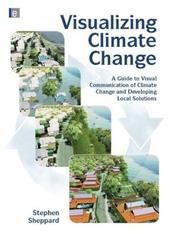
|
Visualizing Climate Change: A Guide to Visual Communication of Climate Change and Developing Local Solutions
Hardback
Main Details
| Title |
Visualizing Climate Change: A Guide to Visual Communication of Climate Change and Developing Local Solutions
|
| Authors and Contributors |
By (author) Stephen R.J. Sheppard
|
| Physical Properties |
| Format:Hardback | | Pages:528 | | Dimensions(mm): Height 246,Width 189 |
|
| Category/Genre | Meteorology and climatology
Social impact of environmental issues |
|---|
| ISBN/Barcode |
9781844078202
|
| Classifications | Dewey:363.73874 |
|---|
| Audience | | Postgraduate, Research & Scholarly | |
|---|
| Illustrations |
615 colour illustrations
|
|
Publishing Details |
| Publisher |
Taylor & Francis Ltd
|
| Imprint |
Earthscan Ltd
|
| Publication Date |
29 March 2012 |
| Publication Country |
United Kingdom
|
Description
Carbon dioxide and global climate change are largely invisible, and the prevailing imagery of climate change is often remote (such as ice floes melting) or abstract and scientific (charts and global temperature maps). Using dramatic visual imagery such as 3D and 4D visualizations of future landscapes, community mapping, and iconic photographs, this book demonstrates new ways to make carbon and climate change visible where we care the most, in our own backyards and local communities. Extensive colour imagery explains how climate change works where we live, and reveals how we often conceal, misinterpret, or overlook the evidence of climate change impacts and our carbon usage that causes them. This guide to using visual media in communicating climate change vividly brings to life both the science and the practical solutions for climate change, such as local renewable energy and flood protection. It introduces powerful new visual tools (from outdoor signs to video-games) for communities, action groups, planners, and other experts to use in engaging the public, building awareness and accelerating action on the world's greatest crisis.
Author Biography
Dr. Stephen Sheppard is Professor in Landscape Architecture and Forestry at the University of British Columbia, Vancouver, and Director of the Collaborative for Advanced Landscape Planning (CALP). He is a leading expert in visualization, and has over 30 years' experience internationally in research and practice in landscape planning, public involvement, environmental perception, and planning for climate change . He was a co-author on the Canadian National Assessment of climate change impacts and adaptation (BC Chapter), and served as a reviewer of the Fourth Assessment Report of the Intergovernmental Panel on Climate Change. He recently served as a Distinguished Scholar in Residence at the Peter Wall Institute for Advanced Studies, UBC.
Reviews'Psychologist Joseph C. Pearce once said, 'Seeing within changes one's outer vision.' Could the reverse be true as well? If we saw without, created tangible visions of what cannot yet be seen, might we change deep within? This book - based on solid science and plenty of practical experience - starts from this affirmative premise: Yes, we visual animals do change our minds and hearts when we see for ourselves what is or could be. Nowhere is it more important to use the power of visioning and visualization than in the context of climate change. This book shows why this is so, and how it can be done effectively and ethically. We must learn from Stephen Sheppard how to use the power of visualization, and then harness the power of seeing, to facilitate the necessary changes toward a responsible, life-affirming, and sustainable future.' Susanne C. Moser, Consultant and Researcher, University of California at Santa Cruz
|